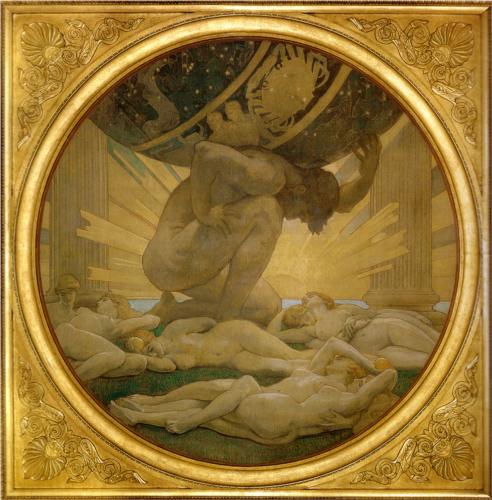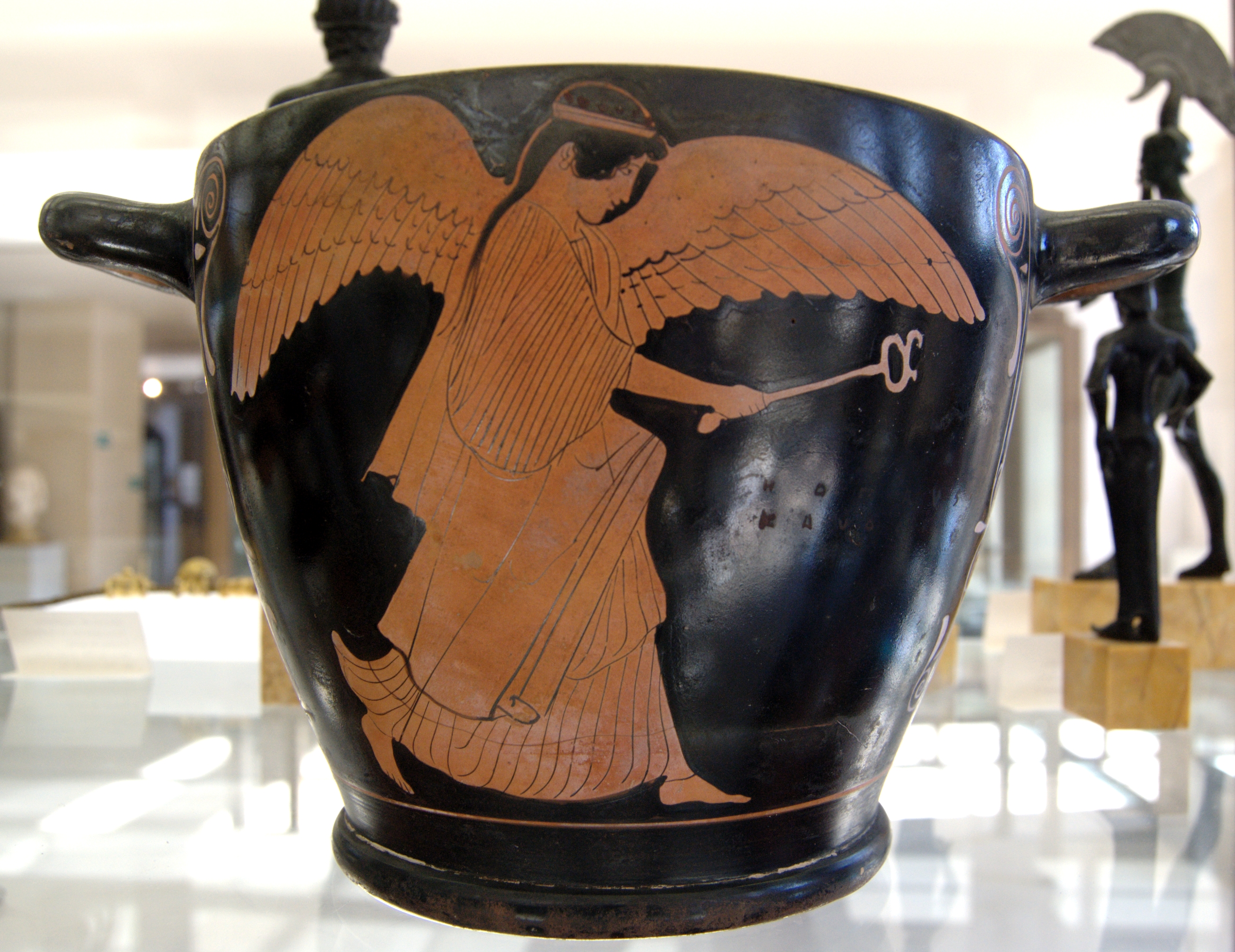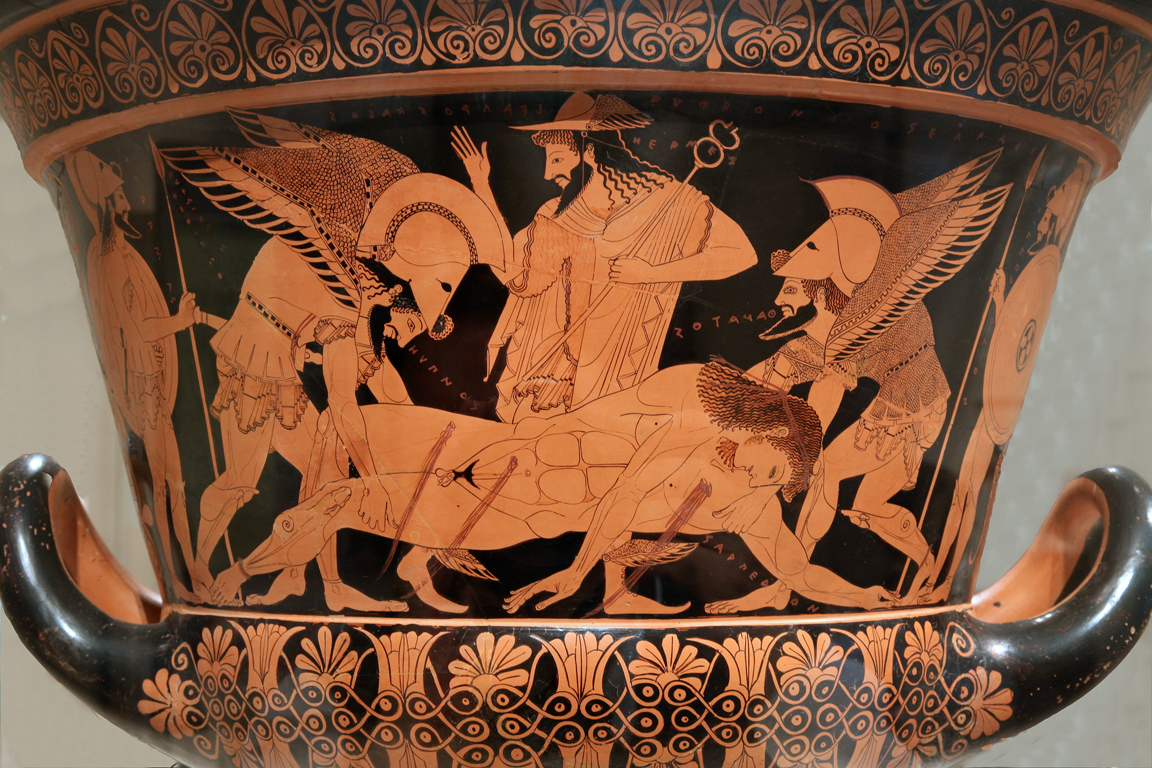
Katherine Joplin –
The study of the psyche is generally considered a relatively modern form of science. One thinks of 20th century archetype thinkers like Sigmund Freud and Carl Jung, who founded psychoanalysis and the beginnings of modern psychology. However, the actual term “psyche” has a much older origin, and was in use long before Freud’s time.
Psyche, orψυχή (psūkhē) as it is written in ancient Greek, is a term often found in the philosophy of Plato, meaning “breath” or “spirit”; while in Freud’s works most associate the psyche with the brain, in Plato it is most often translated as “soul,” a term usually avoided in modern science because of its metaphysical reference. Though psychology in its modern form did not exist until the late 19th century, psychology was seen in a philosophical context in many ancient civilizations, particularly in the works of Plato, Aristotle, Hippocrates and Galen, especially the latter who laid a surprisingly modern foundation. This article will seek to explore the early roots of psychology in Plato’s works and compare them with the theories of the more modern fixture of psychoanalysis, Freud. Harris suggests (Harris, 4) that “there is more sense, common and otherwise, in what the ancients thought and wrote about dreams than scholars have sometimes recognized…” and that we need to acknowledge the “persistent and sometimes sharply perceptive efforts of those who, mainly from the fifth century BC to the first, wrote naturalistic accounts of dreaming.”
Freud’s Id, Ego, Superego, and Plato’s Tripartite Soul
Many will note the striking similarities between Freud’s theory of the id, ego, and superego and Plato’s division of the soul into the appetitive, rational, and spirited.

In Freud’s theory, the mind exists on three levels. The first, the id, first appears when we are born, are consists solely of primal, repressed desires, anxieties, and instincts. It operates solely on the pleasure principle. The second, the ego, contains the conscious part of the mind, is a “coherent organization of mental processes” (Gay 630) and sits on top of the id, forming the “surface of the mental apparatus” (Gay 632). Part of the ego is unconscious, but it is not repressed like the id. The final level of the psyche, according to Freud, is the superego, or ego ideal. In many ways, just as the id tempts the ego to give in to desires and appetites, the superego functions as a conscience, and is an internalization of one’s parents and their higher natures, and punishes the ego for failing to perform with self-judgement and guilt. As one grows up, parents, teachers, and other figures of authority have a powerful influence on the superego (Gay 643).
Plato’s division of the psyche contains similar elements. In his philosophical dialogue, The Republic, Plato’s character, Socrates (based on Plato’s teacher), asserts the necessity of good behavior to have a healthy soul. He first likens the individual to a city with different castes. The laborers, moneymakers, and other self-interested workers make up the appetitive branch; the soldiers and auxiliaries, who keep the working class in place, make up the honor-seeking, spirited branch; lastly, the rulers or “Guardians” make up the highest class, and are considered part of the rational, intellectual branch of the soul. According to Socrates, as with a city-state, one can only be healthy and happy when the different classes work together harmoniously, with “the elements in the soul in a natural relation of mastering and being mastered by one another” (Reeve 134). When one commits an injustice, this throws the different partitions out of balance, perhaps by giving too much power to the appetitive element and weakening the other two.
The first difference one might notice between the two models is there physical organization: Freud sees the rational ego as sandwiched between the id and the superego, reconciling the two. Plato, on the other hand, describes the three parts as stacked with rationality on top, spirit in the middle, and appetite making up the lowest class.
The appetitive element of Plato’s psyche can easily be identified with Freud’s id. Both are rooted in primal desires and greed, and can be associated with the stomach and genitals. They also both make up the lowest level of the tripartite, and must be controlled by the other two elements. The main difference between the id and the appetitive element is in complexity: Freud’s id contains more than simply bodily hungers, including subconscious anxieties (like castration). Moreover, though the appetite makes up the lowest level of the hierarchy, Plato does not conceive of an elaborate subconscious the way Freud does, and does not attribute darker, repressed urges to the appetite the way Freud does the id (Askay and Farquhar, 68).

In the image just above, the winged female carries a caduceus like Hermes; she personifies the rainbow and is possibly the messenger goddess Iris whom the Classical world often thought was sent just before death to end suffering as in Virgil’s Aeneid 4.693 ff.; she also often carries an ewer of water from the river Styx and puts to sleep those who are perjurers.
Plato’s spirited class and Freud’s superego have similarities as well, though not as neatly. According to Askay and Farquhar’s interpretation, “both saw their respective elements as nonrational, yet serving as the ally of reason and opposing appetites/instinctual impulses, and offering it a way to achieve good behavior” (Askay and Farquhar, 68). Both are associated with being accepted into society, and possessing virtues like honor; Freud’s superego is the manifestation of parents’ tutelage and the psyche’s desire to continue to please and obey society. When denied, both of these elements punish the self with anger and shame. However, spirit and superego remain the weakest parallel between the two systems. Plato associates the spirited element with the military, and with aggression, while Freud saw aggression as the “manifestation of the instincts” (Askay and Farquhar, 68).
Both Freud and Plato saw their final partitions, the rational element and the ego, as governing the desires of the other two with reason. Both thought that a healthy person should rely most on rationality, Freud even stating that “it is the task of psychoanalysis to strengthen the ego’s hold on the id” (Askay and Farquhar, 69). One of the main differences between the theories, again, is that Plato’s lacks the psychological complexity of Freud’s. According to Freud, the unconscious desires of the id and the superego can never truly be reigned in by the ego, even that “the ego is not master in its own house.”
It would seem, just as their models differ structurally from each other, the allegory of the city-state must differ for Freud’s psyche as well. While Plato sees the Guardians (the rational mind) holding power over the military (spirit) and laborers (appetitive), Freud’s ego is far more at the mercy of its constituents, and is forever reconciling the conflicting desires of the two. Freud’s model is more like a man with an angel and a devil on each shoulder, or a Guardian trying to appease two warring factions in hopes of reelection.
The two theories exist within different contexts as well. Plato’s tripartite of the soul was established to answer what is goodness, and why a man should be good. Disharmony among the parts is caused by bad deeds; continued disharmony results in a sort of soul sickness (Reeve 133). When one empowered the rational element, one was able to perceive the good, the Forms. In Freud’s case, psychological health had little to do with ‘goodness,’ and more to do with properly recognizing everyday reality and keeping the id in check; the id, ego, and superego were not in disharmony because one was a ‘bad person,’ but because one suffered from neuroses.
A last point of similarity between Freud and Plato exists in their choice of metaphor when describing the rational element’s relationship with the other two: both compare the conscious mind to a rider trying to control his horse, the unconscious mind. “Thus in [the ego’s] relation to the id it is like a man on horseback, who has to hold in check the superior strength of the horse… the ego is in the habit of transforming the id’s will into action as if it were its own” (Gay 636). The superego, in this metaphor, is a force helping the man to keep the horse in check. Plato, on the other hand, sees the spirit and the appetite as two warring horses a charioteer must control, in his dialogue, Phaedrus. The white horse that wishes to fly upward is the spirit element, while the malformed black horse which tries to drag the chariot to the ground is the appetite; the rational element, the man driving the chariot, must reign both in so that he may behold the Forms (McKay). The white horse, or spirit, is depicted here as a force for the rational element to overcome, though it is far easier to control and more virtuous than the black horse. However, the choice of both in illustrating the relationships among the three partitions of their respective theories is intriguing, and suggests Freud may have been well-read in Plato’s works.
Dreams in the Ancient World
Freud’s theory of the id, ego, and superego is key to the modern understanding of dreams. In Freudian thought, dreams are the id’s way of sneaking repressed ideas into the sleeping ego. However, these ideas and images are so disturbing in nature, the subconscious must disguise the “latent content” as something symbolic and seemingly innocuous, the “manifest content.” According to Freud, this meant most trees encountered in the dreamworld were phallic, and caves and tunnels yonic. He also thought the purpose of all dreams was wish fulfillment, and nightmares were glitches in the dreaming, or perhaps masochistic impulses (Gay, Dement and Pelayo). While Freudian dream interpretation is no longer used to study dreams today, it continues to influence modern sleep scientists, and was the foundation for Jung’s theories.
In ancient times, however, sleep was poorly understood, and often considered a sort of temporary death where the soul would leave the body (Dement). Sleep and death were so closely linked that the Greek daemon personification of death, Thanatos, was the twin brother of the daemon of sleep, Hypnos, as seen in the famous Euphronios Krater below, ca 515 BCE, now back in Italy in the Villa Giulia National Museum in Rome. In this Greek vase, we see Hermes in the middle with Thanatos on the right and Hypnos on the left.
Without Freud’s theories of the subconscious, dreams were even less understood, and were often considered supernatural, divine, and occasionally prophetic (Dement and Pelayo, Pearcy). Such beliefs appear often in ancient Greek folklore; Penelope in The Odyssey, for example, dreams of an eagle slaughtering her twenty geese. She is predicting, of course, the return of her husband and the deaths of her suitors through the agency of Zeus whose animal totem is an eagle. Plato’s dialogues sometimes feature prophetic dreams or divine visitations as well; in Crito, the character Socrates dreams that “‘on the third day [he] wouldst come to fertile Phthia,'” an allusion to the Iliad signaling he would be executed the day after tomorrow. Indeed, Socrates’s philosophizing in Crito relies heavily on another dream he had, where he met and was tutored by the personified Laws of society. Many debate whether Crito is a factual account of Socrates’s beliefs and experiences before his death; if it were, then this would be a case of direct intellectual inspiration resulting from a dream, supposedly divine. Even if it is purely a figment of Plato’s imagination, as many believe, it still suggests that Plato put great faith in the prophetic nature of dreams and may even have used some of his own as inspiration for his dialogues.

According to William Harris, however, Plato may have been more skeptical of mystical dream theory, even if he used it extensively as rhetorical devices. Harris suggests that Plato thought dream content was influenced by diet, and used “dream” as a figure of speech “for something subject to diverse interpretations (amphisbetesimos),” and even that Plato was the first surviving writer to postulate that dreams were derived from wish-fulfillment, making his works the prototype for Freud’s theory of dreams (Harris 161).
Though modern science dismisses the divine potential of dreams as pure superstition, there nevertheless has been compelling evidence that dreams can assist with problem solving, and even inspire great intellectual leaps (Dement and Pelayo 276). The structure of the benzene ring, for example, was at last discovered by Fridrich August Kekule when he dreamt of six snakes biting each other’s tails and whirling in a circle; these represented the hexagonal structure of benzene (Dement and Pelayo 276-277). Hermann Hilprecht, a professor of Assyrian, dreamt that a priest told him the translation of the Stone of Nebuchadnezzar (Dement and Pelayo 277). Numerous intellectuals attest to the problem-solving nature of dreams; in the past, these might well have been understood to be divinely inspired. The mystical dreams of the ancient world, in that sense, might not be so unrealistic.
The ancient Greeks associated divine dreams with healing as well. In many sites throughout Greece and Asia Minor, worshippers of the Greco-Roman god of healing, Asclepius, built sanctuaries and temples associated with sacred springs, perhaps the most important one at Epidauros. It was thought that Asclepius “effected cures of the sick in dreams,” or gave them “clues regarding their healing.” To that end, pilgrims would bathe in his spring and sleep within the temple precincts, or abaton (“Asklepion Shrine”). The Roman physician, surgeon, and philosopher, Galen of Pergamon, claimed to receive instructions on a radical new therapy in a series of dreams, in this case, the letting of blood from arteries. He did not state that the dream came from Asclepius, but did mention a patient and suppliant of Asclepius who was saved by a similar method (Mattern 79). While such divinely inspired medical dreams are viewed in modern times as irrational and unsafe (indeed, Galen’s arterial blood letting is generally not prescribed today), health-related dreams are known to occur in people anxious about unhealthful lifestyle choices. Dr. William C. Dement, a renowned sleep researcher, credits a dream for ending his smoking habit. In this dream, Dr. Dement was diagnosed with terminal lung cancer and was even given an x-ray showing his ravaged lungs. Thus, while science cannot realistically credit gods of healing for inspiring people to change their lifestyles, there is evidence to suggest dreams can readily illustrate subconscious concerns in at-risk patients. As with the problem-solving nature observed in dreams, had Dr. Dement’s lifesaving dream occurred in a temple of Asclepius and in the 5th century, his dream would have undoubtedly been interpreted as a divine message from the god of medicine himself.
Conclusion
Though we see scientific understanding as a relatively recent phenomenon, people have been interacting with and observing their world for centuries, inside and out. While there are numerous and profound improvements in today’s technology and scientific method, there are also surprising parallels and similarities between the theories of the modernity and ancient times. Indeed, no matter how much we chide the ancient Greek philosophers for their conservative views and superstitions, we return again and again to their works, finding newer ways they ring true in the modern era.
Bibliography
Askay, Richard, and Jensen Farquhar. Apprehending the Inaccessible: Freudian Psychoanalysis and Existential Phenomenology. Evanston: Northwestern University Press, 2006.
Dement, William C., and Rafael Pelayo. Dement’s Sleep & Dreams. Palo Alto: Stanford University Center for Sleep Sciences and Medicine, 2013, 276-324.
Gay, Peter. The Freud Reader. New York: W.W. Norton & Company, 1989, 628-58. Print.
Harris, William. Dreams and Experience in Classical Antiquity. Cambridge, MA: Harvard University Press, 2009, 4.
Mattern, Susan P. The Prince of Medicine: Galen in the Roman Empire. New York: Oxford University Press, 2013. 79-80
McKay, Brett, and Kate McKay. “What Is a Man? The Allegory of the Chariot.” The Art of Manliness. 04 Mar 2013 (online 21 May 2013) <http://www.artofmanliness.com/2013/03/04/what-is-a-man-the-allegory-of-the-chariot/>.
Pearcy, Lee T.. “Dreams in Ancient Medicine.” Medicina Antiqua. 21 May 2013. <http://www.ucl.ac.uk/~ucgajpd/medicina antiqua/sa_dreams.html>.
Reeve, C.D.C. Republic. Indianapolis: Hackett Publishing Company, 2004, 103-35.